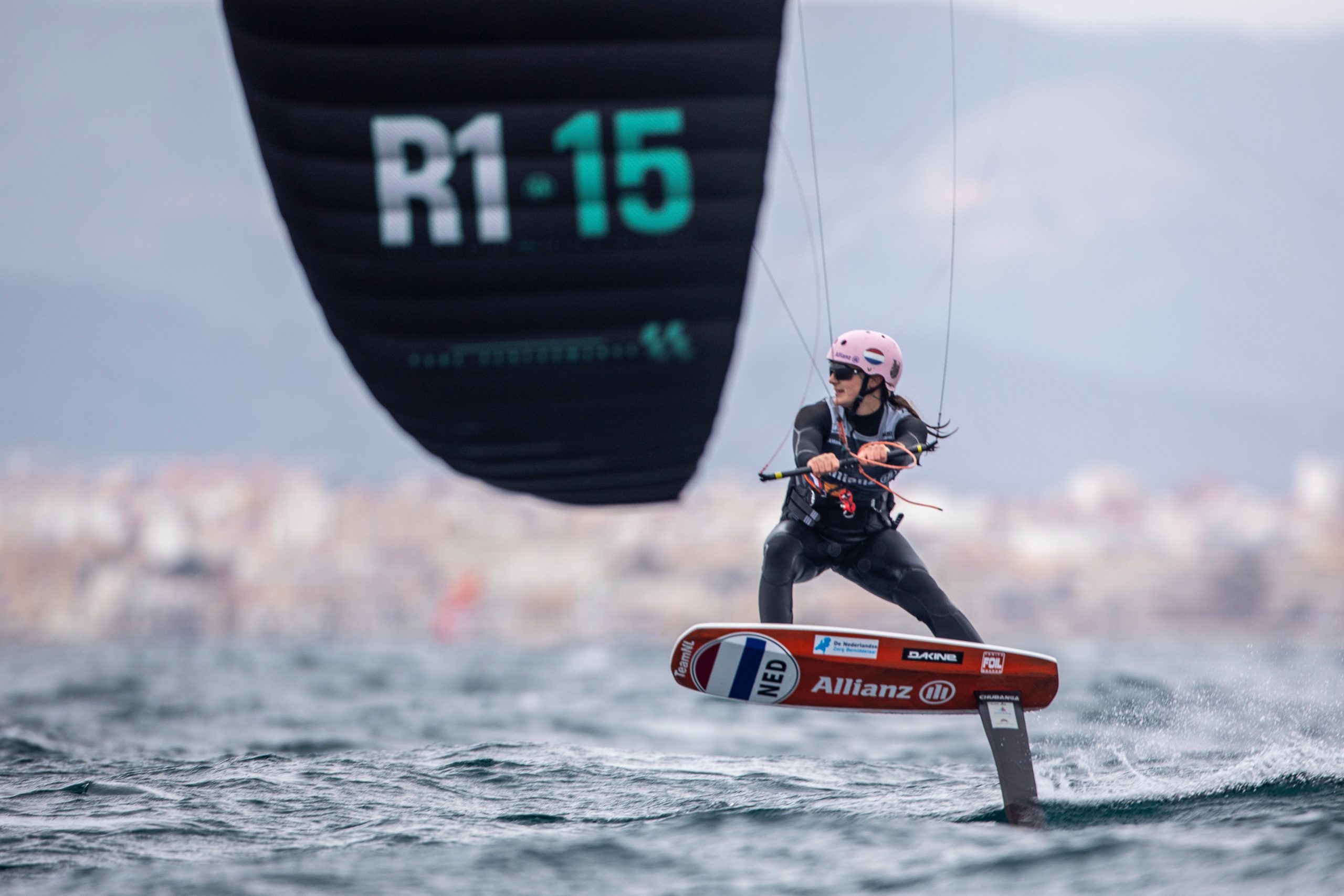In een few weeks, Annelous Lammerts will compete in the first Olympic kitesurf competition ever. TU Delft designed an aerodynamic and tear-proof suit specially for her.
Annelous Lammerts in action in the waters of Mallorca. (Photo: Sander van der Borch/Watersportverbond)
Kitesurfer Annelous Lammerts has just returned from Marseille where she trained in the same waters where the sailing competitions in the Olympic Games will be held. She is at TU Delft for the presentation of her new competition suit in which she will tear across the Mediterranean Sea at up to 75 kilometres an hour between 4 and 8 August en route to a medal.
But it is not all plain sailing, there are risks involved. The foil – the rudder like wing that lifts the board out of the water – is extremely sharp. From time to time there are crashes and the surfers are left with deep cut wounds. Up to now, Lammerts, who is the only Dutch competitor in the Formula Kite category, has remained largely unhurt, but she is aware that accidents do happen in her sport.
Tear proof
Apart from the aerodynamics, higher speeds and seconds gained, perhaps the most important thing to her is that the suit, that was specially designed for her and was presented on Tuesday, is tear proof. “You’re always calculating the risks. If the wind is blowing hard, you know that everyone will be pushing the limits and that someone can fall right in front of you at any time.” She has greater confidence knowing that her suit will protect her from serious lacerations.
In her sailing discipline this is where the chance of an incident is the highest. “In contrast to other disciplines, we have a very small light board that continues to race on even if you fall off. You have so many situations in which you have close shaves.” Team Allianz, Lammerts’ sailing team, had already started thinking about innovations that could help four years ago.
‘It gives you even more confidence when you know that everything is being done to win a medal’
Researchers at TU Delft and WEEV Textiles started working on developing the new suit. WEEV Textiles came up with a special type of thread made from a combination of materials. What these are is confidential. However, Bart Groenewoud (WEEV Textiles) can say that the material has proven its use in other areas such as the glass industry and the fire brigade.

Air resistance
Wouter Terra is a researcher at Aerospace Engineering (AE) and NOC*NSF (the umbrella organisation for sports in the Netherlands) and worked on the suit’s aerodynamics. The sleeves’ exterior is made of a smooth material, while the interior is grooved, explains Terra. “It pushes through as it were so that the friction of the air on the arms drops.” As Lammerts’ legs are perpendicular to the board, the leg sections are made of the smooth material.
Before this combination emerged as the winner, Terra and his team tested countless combinations in the AE’s wind tunnel on TU Delft’s campus. They did this in both wet and dry conditions as the surfers get soaked during their races.
Neoprene
The prototypes were also extensively tested in real conditions. These too generated a lot of information. The team originally avoided neoprene, the material that is usually used in wetsuits. But when Lammerts felt that the suit did not fit comfortably, a piece of neoprene was added to the crotch.
The suit’s torso is made from a different material. This is because the surfers are required to wear another two layers – a protective impact suit and a ‘Lycra competition suit’. To customise them as much as possible, the sewing machine and safety pins will also go to Marseille. This will reduce the air resistance by up to 10 percent, says Terra.
Lammerts is counting the days. In less than one month she will start her Olympic adventure and her group will take to the water on 4 August. The hopeful Olympian does not believe everything will only be down to the suit. “But it gives you even more confidence when you know that everything is being done to win a medal.”
Aerodynamic Olympic innovations
Lammerts’ tear-proof suit is just one of three aerodynamic sports innovations on which Terra has recently worked for TU Delft and NOC*NSF. TU Delft also worked on personalised bicycles for track cyclists. All of them can be added to the ever longer list of professional sports developments from TU Delft’s innovation space.
And this has a wider impact, says Terra. “We learned what kind of materials are more slippery than others when we designed the sled and suit for Kimberly Bos, the skeleton sled rider. We used that information in Annelous’ suit.” The material used in the suit that had previously been developed for Olympic skaters also resembles the material in this new kitesurfing suit.



Comments are closed.